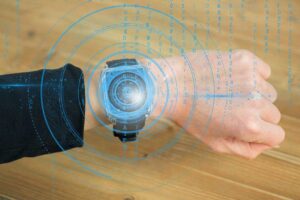
Revolutionizing Wearables: The Rise of Smart Clothing with Embedded Sensors
As technology advances, it continues to impact every aspect of our lives. One area where technology has made significant strides is in the field of clothing. Smart clothing, also known as e-textiles, is a type of wearable technology that incorporates sensors, microprocessors, and other electronics to collect data and provide various functionalities. Among the key components of smart clothing is the smart sensor, which can be embedded in various types of clothing to enable real-time monitoring and analysis of a wide range of metrics. In this article, we will explore the concept of smart clothing with a smart sensor and its potential applications.
What is Smart Clothing with a smart sensor?
Smart clothing with smart sensors is a type of wearable technology that integrates electronic sensors directly into traditional clothing materials to monitor and transmit data about the wearer’s physical state, activity level, and environment. These sensors can be used to collect a wide range of data, such as heart rate, body temperature, movement, and location, which can then be processed and analyzed to provide insights into the wearer’s health, fitness, and daily routines.
Smart sensors in clothing can take many forms, depending on the specific application and desired data collection. For example, some smart clothing may have sensors integrated directly into the fabric, while others may use small, flexible sensor devices attached to the clothing. Some of this clothing may use optical sensors that measure light absorption or reflection, while others may use pressure sensors that measure the force applied to the fabric.
The data collected by smart sensors in clothing can be transmitted wirelessly to a smartphone or other device, where it can be analyzed and used to provide personalized feedback and insights. For example, a smart shirt with heart rate sensors can provide real-time feedback on the wearer’s cardiovascular health during exercise, while a smart jacket with temperature sensors can provide alerts when the wearer is at risk of hypothermia.
Overall, this clothing with smart sensors is a growing field of wearable technology that has the potential to revolutionize how we monitor and manage our health, fitness, and daily routines.
How Smart Clothing Works
Smart clothing, also known as e-textiles or electronic textiles, incorporates electronic components and sensors into traditional fabric materials to create wearable technology that can monitor and transmit data. The technology behind smart clothing is constantly evolving and advancing, but here is a basic overview of how it works:
Sensors: Smart clothing is embedded with sensors that can detect various measurements and signals, such as temperature, heart rate, motion, and even GPS location. The sensors can be integrated directly into the fabric, or they can be attached to the clothing as small, flexible devices.
Conductive yarns and fabrics: This clothing uses conductive yarns and fabrics that can transmit electrical signals throughout the garment. These materials are often made from metal fibers, such as silver or copper, that can conduct electricity without compromising the comfort or flexibility of the fabric.
Microcontrollers: Smart clothing often includes a small computer called a microcontroller that can process the data collected by the sensors and control any output devices, such as LED lights or vibration motors. The microcontroller can also transmit the data wirelessly to a smartphone or other device.
Power source: This clothing requires a power source to run the sensors, microcontroller, and output devices. This can be a small battery or a rechargeable power source, such as a USB cable or solar panel.
Applications: Smart clothing can be used in a variety of applications, from fitness and health monitoring to safety and security. For example, a smart shirt with heart rate sensors can help monitor the wearer’s cardiovascular health, while a smart jacket with built-in lights and GPS can increase visibility and safety while cycling at night.
Overall, smart clothing works by integrating sensors, conductive materials, microcontrollers, and power sources into traditional fabrics to create wearable technology that can monitor, process, and transmit data.
What is a smart sensor for workers and what is its use?
Smart sensors for workers are electronic sensors that are designed to be worn or integrated into personal protective equipment (PPE) to monitor workers’ health and safety in hazardous or industrial environments. These sensors can detect a wide range of data, such as temperature, humidity, air quality, noise levels, and movement, and transmit the data wirelessly to a central hub or monitoring system.

The use of smart sensors for workers can provide several benefits, such as:
Improved safety: Smart sensors can alert workers and supervisors to potential hazards in real-time, such as dangerous levels of toxic gases or excessive heat.
Early detection of health issues: Smart sensors can monitor workers’ vital signs, such as heart rate and body temperature, and alert supervisors to potential health issues before they become more serious.
Enhanced productivity: Smart sensors can provide valuable data on worker activity levels, which can be used to optimize workflows and improve efficiency.
Improved compliance: Smart sensors can help ensure that workers are following safety protocols and using PPE correctly, which can help organizations comply with regulatory requirements.
Some examples of smart sensors for workers include:
Wearable health monitors: These sensors can monitor workers’ vital signs, such as heart rate, blood pressure, and body temperature, and transmit the data wirelessly to a central monitoring system.
Environmental sensors: These sensors can monitor air quality, temperature, and humidity in industrial or hazardous environments, and provide alerts when levels exceed safe thresholds.
Motion sensors: These sensors can monitor worker movement and activity levels, and provide data on worker fatigue and efficiency.
Overall, smart sensors for workers can play a critical role in promoting worker safety and health and can help organizations improve productivity and compliance in hazardous or industrial environments.
The difference between smart clothing and smart sensors?
Smart clothing and smart sensors are related concepts in the field of wearable technology, but they refer to different aspects of the technology.
Smart clothing refers to traditional clothing items that have been enhanced with electronic components and sensors to collect data about the wearer’s physical state, activity level, and environment. This clothing can be used for a wide range of applications, such as health and fitness tracking, sports performance monitoring, and lifestyle tracking. Examples of smart clothing include smart shirts with heart rate sensors, smart socks with motion sensors, and smart jackets with temperature sensors.
On the other hand, smart sensors refer to the electronic sensors themselves that are used in wearable technology, including smart clothing. Smart sensors can take many forms and can be used for a variety of applications. Some examples of smart sensors include temperature sensors, motion sensors, heart rate sensors, and environmental sensors.
In summary, smart clothing is a type of wearable technology that incorporates electronic components and sensors into traditional clothing items, while smart sensors are the electronic sensors themselves that are used in wearable technology, including smart clothing. Smart sensors are a critical component of smart clothing, as they enable the collection of data that can be used to provide insights and feedback to the wearer.

Which cost is more appropriate?
The cost of smart clothing and clothing with protective sensors can vary depending on a variety of factors, such as the type and quality of the sensors used, the complexity of the design, and the brand and manufacturer. In general, this clothing tends to be more expensive than traditional clothing, due to the added cost of the electronic components and sensors.
Clothing with protective sensors can also be more expensive than traditional clothing, particularly if it is designed for use in hazardous or industrial environments where the sensors and materials need to meet specific safety standards. However, the cost of protective clothing can be seen as an investment in worker safety and maybe a worthwhile expense for companies and organizations that prioritize employee well-being.
Ultimately, the cost of smart clothing and clothing with protective sensors will depend on the specific use case and the intended functionality. Both types of clothing can provide significant benefits in terms of health, safety, and performance, and the cost should be evaluated for the potential benefits and return on investment.
Smart Clothing May Be the Future of Wellness Technology
This clothing has the potential to revolutionize the way we monitor and improve our health and wellness. With its ability to integrate sensors and electronic components directly into the fabric, this clothing can provide a comfortable and convenient way to collect and transmit real-time data about our physical state and activity level.
One of the key benefits of smart clothing for wellness technology is its ability to provide continuous monitoring of important health metrics, such as heart rate, breathing rate, and body temperature. This can enable wearers to track changes in their physical state over time, identify potential health issues early on, and make more informed decisions about their lifestyles and activities.
Smart clothing can also be used to monitor activity levels and provide real-time feedback on performance during exercise or other physical activities. This can help wearers optimize their workouts, improve their technique, and prevent injury.
In addition to health and fitness tracking, this clothing can also be used for a variety of other wellness applications, such as stress monitoring and management, sleep tracking, and posture correction.
Overall, the potential applications of smart clothing in wellness technology are vast and exciting, and we are likely to see continued development and innovation in this field in the years to come. As technology improves and becomes more accessible, this clothing may indeed become the future of wellness technology.
Summary
In conclusion, smart clothing with smart sensors is revolutionizing the way we approach clothing design and use. By combining technology and fashion, these garments can provide valuable data and insights to improve our health, safety, and overall quality of life. As the Internet of Things continues to grow and evolve, we can expect to see even more innovative uses of smart clothing and sensors in various industries and applications.

Write a Comment